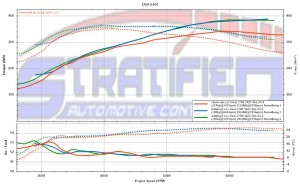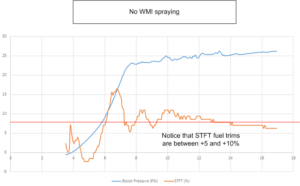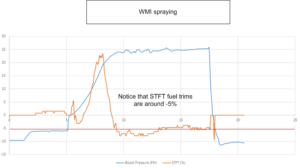Turbochargers like high octane and a cold intake charge. Using a water-methanol injection system (WMI) to fulfill that need is effective in terms of results as well as costs (especially if high octane fuel like E85 is not readily available). These injection systems were used in aircraft before World War II and more recently even BMW implemented a system in their M4 GTS. The results speak for themselves – more reliable power!
The issue with these systems (and any system) is that they can fail, leak, or get clogged. To maintain reliability we need to be able to detect this. There are several ways to go about failure detection. One is to purchase a system with a failsafe while another is to look at temperature differences in the charge air. However some cars (such as the Ecoboost engines) have the charge air temperature sensor BEFORE the injection nozzle (at the intercooler outlet). Unfortunately due to this sensor placement, it will not pick up the difference in temperatures brought on by the WMI spray.
For these vehicles we have another indicator as to whether or not WMI is indeed working. Methanol is combustible. This means that if you inject it, it will affect total fueling entering the engine. The Ecoboost has a sensitive wideband oxygen sensor and it adjusts fueling in real time under wide open throttle (when WMI is also spraying).
This means that you can datalog or monitor your short term fuel trims (STFT) to see if WMI is injecting when it’s supposed to under boost. First you must establish a baseline and check that the system works. Before you turn your WMI system on, take a WOT datalog and make note of your STFTs under boost with WMI off.
In the graph above you will see that the STFT settles between positive +5 to +10%. This means the ECU is detecting that it should inject 5-10% extra fuel to meet the fuel targets in the tune. In similar temperatures and without adjusting boost, turn the WMI system on and take another datalog.
You can see that now at the same boost pressure and with WMI injecting the STFT reading has dropped to -5%. This means that WMI is contributing to around 10-15% of the total fueling on this particular car and setup and the ECU is now taking away 5% of the fuel instead of adding 5-10%. Excellent, now you have verified that the WMI system works and have seen its effects on fuel trims. This is your new baseline for fuel trims with the WMI system working.
If the system were to fail, you will see not just additional knock, but also a shift of the STFTs towards positive territory as that extra fuel is no longer supplied.
Keep in mind that engine part changes, WMI nozzle changes, different temperatures, changes in boost pressure, and fueling system changes overall (including the fuel used) will affect the fuel trims in varying degrees. However if you often monitor your car you will have a good idea where the STFT trims sit under WOT with WMI working. If you see a sudden positive shift in those trims accompanied by knock under steady wide open throttle and boost, you should inspect that your water-methanol system is leak free and still delivering the liquid to the engine.
Keeping things fueled and cool,
The Stratified Team





